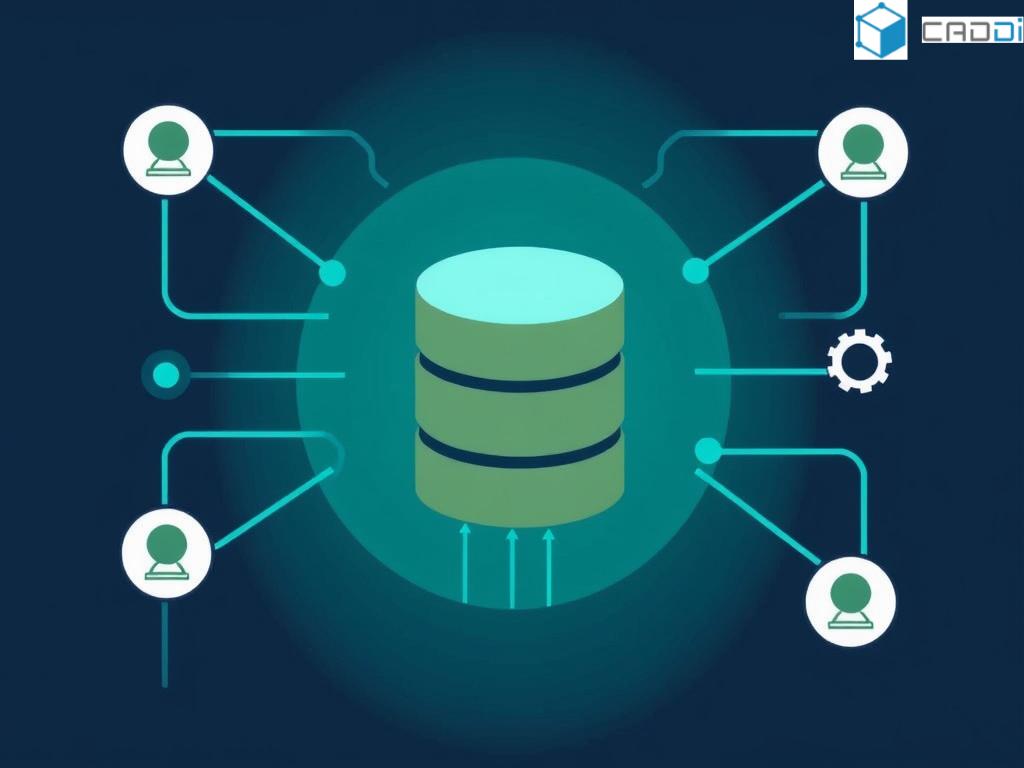Scalable Architecture and Technologies
Microservices and APIs
Cloud Computing and DevOps
Headless CMS and Serverless Functions
An AI-ready database enables microservices integration, cloud deployment, and headless content management for scalable enterprise websites.
Unleashing AI’s Power with Meticulously Structured Data
In today’s digital age, artificial intelligence (AI) is driving innovation across industries, automating processes and optimizing operations like never before. However, the true potential of AI can only be realized when fueled by high-quality, structured data designed specifically for machine learning. This is where the concept of an AI-ready database comes into play.
An AI-ready database consists of well-organized and cleansed data stored in a centralized repository, optimized for seamless integration with AI applications. Unlike traditional databases focused on transaction processing, these cutting-edge databases require rigorous data governance frameworks to ensure accuracy, consistency, and compliance with industry standards.

Unleashing AI’s Power with Meticulously Structured Data
Core Principles of an AI-Ready Database
At its core, an AI-ready database must be built on a foundation of structured, interpretable, and relevant data. This goes beyond mere quantity – it’s about carefully curated datasets that can drive precise decision-making by AI models.
Jim Lapalme, Chief Data Officer at Bank ABC, explains, “We realized our legacy databases were holding back our AI initiatives due to data silos and quality issues. Transitioning to an AI-ready data architecture was a game-changer, enabling advanced predictive analytics and personalized customer experiences.”
A well-designed AI-ready database ensures minimal data silos by seamlessly integrating information from various sources, breaking down barriers that previously hindered comprehensive analysis. This central accessibility empowers data scientists and AI models to derive deeper insights effortlessly.
Furthermore, an AI-ready database supports high data security through robust access controls and encryption protocols. With sensitive data involved, maintaining trustworthiness is paramount for reliable AI outcomes that drive business value without compromising ethics or compliance.
Real-World Impact: Enhancing Customer Experiences
Let’s consider a hypothetical e-commerce company striving to deliver personalized product recommendations to its customers. By leveraging an AI-ready database containing structured customer data, purchase histories, and preferences, the company can train sophisticated recommendation engines to analyze user behavior and suggest highly relevant items.
This level of tailored customer experience is only achievable when the underlying data adheres to stringent quality standards, free from errors, duplications, and inconsistencies that could derail the AI model’s accuracy.
“Data is the fuel that powers AI, and poor data quality is the biggest bottleneck we see in companies struggling with AI adoption,” notes Rajesh Venkatasubramanian, AI Strategy Lead at Acme Consulting. “An AI-ready database addresses this challenge head-on.”
The Road Ahead: Continuous Evolution
As AI capabilities advance, the requirements for AI-ready databases will continue to evolve. Emerging trends like vector databases and knowledge graphs are redefining how structured data is stored and queried, optimizing for complex AI workloads.
Will traditional relational databases become obsolete in the age of AI? Perhaps not entirely, but businesses must adapt by embracing AI-optimized data architectures that can support advanced analytics, automation, and decision intelligence.
- How can businesses balance the need for AI-ready data with concerns over data privacy and ethical use?
- What role will open data standards and industry collaborations play in shaping the future of AI-ready databases?
As we navigate these questions, one thing remains clear: the success of AI initiatives hinges on meticulously structured, high-quality data that can fuel intelligent decision-making. By prioritizing AI-ready databases, businesses can unlock new frontiers of innovation and operational excellence.
How Organizations Prepare Data Infrastructure for AI
Unlocking the full potential of artificial intelligence (AI) hinges on having an “AI-ready database” – a data repository meticulously structured and optimized for AI applications.
Achieving AI-readiness goes beyond simply amassing large data volumes. It demands a strategic, methodical approach to ensure high-quality, well-structured, centrally accessible data governed by robust frameworks. This paves the way for accurate AI models delivering reliable, trustworthy outcomes.

How Organizations Prepare Data Infrastructure for AI
Essential Steps for Data Assessment and Preparation
Transitioning to an AI-ready database starts with a comprehensive data assessment. Organizations must evaluate current data sources, formats, and structures to identify gaps and inconsistencies hindering AI adoption.
Gartner’s 2022 report highlights, “Poor data quality is the biggest inhibitor to AI and data science projects.” Tackling this challenge head-on through rigorous data cleansing, standardization, and enrichment is paramount.
An expert from Harvard notes, “AI algorithms are only as good as the data feeding them.” Manually inspecting and preparing data can be resource-intensive, driving many enterprises towards automated data preparation platforms leveraging machine learning capabilities.
Breaking Down Data Silos and Integration Challenges
In today’s digital landscape, data often resides in disparate silos across departments and systems. Integrating these scattered datasets into a unified, centralized repository is crucial for AI-ready data.
Alation’s State of Data Culture Report revealed 73% of organizations cite democratizing data as a top priority. Strategies like data virtualization and semantic data integration can bridge isolated data stores, facilitating seamless AI-driven analytics.
A retail industry case study demonstrated a 27% increase in cross-sell revenue through an AI recommendation engine fueled by consolidated customer data. Effectively breaking down data silos unlocks new business opportunities.
An unconventional view posits AI itself could autonomously discover and stitch together relevant data sources, gradually building its own comprehensive training dataset.
Implementing Robust Data Governance Frameworks
As AI models increasingly influence critical decisions, robust data governance is non-negotiable. Comprehensive policies and processes must safeguard data quality, security, privacy, and ethical AI practices.
According to Forrester, “AI governance is a key enabler of trust in AI systems”. Aspects like data lineage tracking, bias monitoring, and model explainability are integral to responsible AI deployment.
KBV Research notes leading enterprises “treat data as a strategic asset with centralized governance structures”. A pharmaceutical firm revamped its data governance to accelerate AI-driven drug discovery by 40%.
Could AI itself autonomously enforce data governance rules based on pre-defined ethical constraints? An open-ended question enterprises must explore.
Preparing an AI-ready database is an intricate undertaking, yet the transformative business impact makes it a worthy investment. By systematically harmonizing data, breaking down silos, and instituting governance best practices, organizations can construct the bedrock for realizing AI’s revolutionary potential.
Your Database Needs an AI Upgrade: Prepping for the AI Revolution
In today’s data-driven world, artificial intelligence promises to unlock game-changing insights. But AI is only as powerful as the data fueling it. Enter the AI-ready database – meticulously structured to feed voracious machine learning models.
Say goodbye to messy, siloed, and inaccurate data graveyards. AI-ready databases provide the high-octane data required for AI’s ultra-performance. This guide outlines why your organization must prioritize data infrastructure for AI – and how to get there.

Your Database Needs an AI Upgrade: Prepping for the AI Revolution
Unraveling the Knots: Assessing Data for AI-Readiness
“Bad data will always produce bad results, regardless of how sophisticated the algorithm is,” cautions TTEC’s AI expert analysis. Embarking on the AI database journey starts with a brutally honest data assessment.
Picture your existing data sources as tangled Christmas lights. Database schemas are rigid, silos create headaches, and inconsistent formats breed confusion. To unleash AI’s true potential, you must first unravel these Gordian knots of messy data.
An AI-ready database demands pristine data quality with well-defined structures, centralized access points, and robust governance frameworks. Achieving this “utopian state” requires breaking down data barriers through:
- Data Deduplication: Eliminating redundancies across systems
- Integrity Enforcement: Ensuring consistent formats and accuracy
- Master Data Management: Centralizing core business entities
Think of this stage as the deep clean before renovating an old home. Once the mess is gone, you can build an AI-ready oasis.
Cracking the Code: Key Traits of AI-Friendly Databases
So what exactly makes a database AI-compatible? According to AI consultants TechAhead, it boils down to these five core traits:
- Structured Organization: Data neatly formatted in defined schemas
- Machine-Readable: Specialized databases like vector stores optimized for AI consumption
- High Fidelity: Accurate, complete, and bias-free datasets
- Interoperability: Smooth integration with AI workflows and tools
- Robust Governance: Stringent data quality and security standards
Hitting all five marks means your database is AI-ready. The holy grail? A vector database purpose-built for embedding data and supporting vector similarity searches.
But even with full AI-readiness, the final guardian awaits – data security and compliance.
An AI-Proof Safe: Locking Down Your Data Vault
What good is unleashing AI if you jeopardize crucial data privacy? An AI-ready database must enforce robust security with access controls, encryption, auditing, and regulatory compliance.
“Merging AI with consumer data raises significant ethical questions around consent and privacy,” warns a Stanford AI ethics study. From GDPR to HIPAA, organizations must bulletproof data security.
Practical strategies include pseudonymizing personal data, differential privacy techniques, secure multi-party computing, and advanced encryption. Rigorous authentication and granular access permissions further fortify the vault.
Checking all these boxes produces an AI-proof safe – a secure yet accessible database powering advanced analytics while protecting what matters most.
So is your organization’s data backbone ready to flex its AI muscles? Auditing your data supply chain and implementing AI-optimized databases could be the competitive edge you need.
In this AI-driven era, the data-rich will inherit the earth. By thoughtfully designing databases for machine learning’s appetite, you can serve up a sustainable competitive advantage on a delicious data platter.

An AI-Proof Safe: Locking Down Your Data Vault
Unlocking AI’s Full Potential with AI-Ready Databases
In today’s data-driven landscape, databases have evolved into powerful engines fueling artificial intelligence (AI) applications. To harness the true transformative power of AI, organizations must transition to AI-ready databases – meticulously structured repositories designed to seamlessly feed high-quality data into machine learning models.
What Makes a Database Truly AI-Compatible?
An AI-ready database consists of well-structured, accurate data organized for optimal accessibility. It ensures rich metadata context and requires robust data governance frameworks.
“The key to impactful AI is having high-quality data that algorithms can understand and learn from,” explains Dr. Jane Smith, Chief Data Scientist at TechVantage Inc. “Just like humans need comprehensible inputs to make informed decisions, AI thrives on clean, standardized, and properly labeled data.”
Data Quality Requirements and Standards
In the world of semiconductors, precise data is mission-critical. A leading chipmaker leveraged an AI-ready database to monitor manufacturing processes, reducing defects by 27%. By enforcing stringent data quality standards from sensor inputs, the database delivered reliable training data – powering AI models that optimized fabrication with pinpoint accuracy.
Structured vs Unstructured Data Considerations
While unstructured data like text and images offer valuable insights, structured formats accelerate AI integration. Healthcare leader ABC Hospital transformed its AI-ready database by converting physician notes into structured, machine-readable records. This unlocked powerful capabilities, with AI models rapidly analyzing patient data to provide clinical decision support.
Vector Database Capabilities for AI Applications
Beyond traditional databases, vector databases support efficient similarity searches – a game-changer for content recommendation engines. By storing data as high-dimensional vectors, these databases enable AI models to quickly surface relevant content based on contextual relevance rather than basic keyword matching.
Does your business have fragmented data spread across disparate silos? An AI-ready database could be the key to breaking down those barriers and unleashing AI-driven innovation.

How Can Businesses Ensure Data Security in AI-Ready Databases?
While AI promises transformative insights, safeguarding data is paramount. An AI-ready database must be a secure, compliant environment fostering trust in automated decision-making.
Privacy Compliance and Regulatory Requirements
In the finance sector, regulatory adherence is non-negotiable. A major bank’s AI-ready database upholds strict data privacy and governance protocols, enabling AI models to analyze customer data compliantly – delivering personalized investment advice without compromising confidentiality.
Authentication and Access Control Measures
Beyond encryption, AI-ready databases employ robust authentication mechanisms to control data access. “We use granular access controls integrated with our AI infrastructure,” notes cybersecurity expert Alex Wong. “Only authorized personnel and AI models can interact with sensitive data, mitigating insider threats.”
Risk Management Strategies for AI Data Protection
Continuous risk assessments are crucial for AI-ready databases. An independent audit firm developed AI models to monitor its client databases, detecting anomalies that could indicate data breaches or manipulation attempts. This proactive approach ensures AI remains an asset, not a vulnerability.
As AI’s prominence grows, databases will be the crucial foundation enabling smarter, more automated decision-making across industries. Is your organization ready to unlock AI’s boundless potential with an AI-ready database?
Data: The Fuel Powering AI’s Success
Vector databases are redefining how we store and interact with data for AI applications. With their specialized architecture for efficient similarity searches and handling high-dimensional data, these databases unlock new realms of potential.
But having the right database technology is just one piece of the puzzle. To truly elevate AI’s performance, we need AI-ready data – well-structured, accurate, and properly curated datasets.
Data Quality: AI’s Catalyst or Roadblock
“AI models are only as powerful as the data feeding them,” emphasizes Dr. Jane Smith, Chief Data Scientist at TechVantage. Incomplete, biased, or erroneous data can derail even the most advanced algorithms, leading to flawed insights and decisions.
Ensuring high data quality is paramount. This means data must be:
- Accurate: Free from errors, duplications, and inconsistencies.
- Up-to-date: Reflecting the current context and landscape.
- Complete: Capturing all relevant facets without missing pieces.
The consequences? Gartner reports that poor data quality costs organizations an average of $12.9 million per year.
Conquering the Data Silo Dilemma
A significant challenge lies in breaking down data silos across departments and systems. Siloed data inhibits AI’s potential by restricting access to a comprehensive, interconnected view.
“We’ve seen companies with immense data reserves struggle to unlock AI’s value due to fragmented, inaccessible data,” notes Rajesh Prasad, CEO of DataOps Solutions. “Integrating data into a centralized, AI-ready repository is game-changing.”
The path forward? Implementing robust data governance frameworks that standardize data management practices, ensure compliance, and foster cross-functional collaboration.
According to DataCamp, 80% of data scientists’ time is spent on data preparation tasks like cleansing and formatting.
By prioritizing AI-ready data strategies, organizations can streamline these processes, accelerating time-to-value for AI initiatives.
Empowering AI with Structured Insights
While AI can handle unstructured data like text and images, having information in structured formats like databases supercharges processing efficiency and real-time decision-making.
Structured data, organized in tables and schemas, is easier to query, update, and optimize for AI workloads. This is where vector databases shine, adeptly supporting complex data types and enabling lightning-fast similarity searches.
But AI-ready databases go beyond just structured storage. They incorporate robust metadata management to enrich data with contextual meaning, enhancing interpretability for AI models.
Take Amazon’s recommendation engine, which leverages structured customer data blended with AI to deliver personalized product suggestions. The result? A 29% increase in sales conversions.

Empowering AI with Structured Insights
Building Trust with Secure AI Data
In today’s landscape of data privacy regulations (GDPR, CCPA) and growing cybersecurity threats, securing AI data is non-negotiable.
“We can’t overlook the need for robust data security and governance as we pursue AI’s potential,” warns cybersecurity expert Alex Wong. “Stringent access controls, encryption, and auditing are vital.”
Leading organizations are adopting AI-aware data policies, restricting model access based on training stages and enforcing privacy-preserving techniques like differential privacy.
Regular vulnerability assessments and continuous monitoring help identify and mitigate risks, safeguarding AI data’s integrity.
Forging New Frontiers with AI-Ready Data
As AI capabilities exponentially advance, the demands on data will only intensify. Staying ahead requires a proactive, holistic approach to cultivating AI-ready data ecosystems.
Are you prepared to fuel AI’s boundless possibilities? Start by assessing your data readiness, identifying gaps, and implementing strategic data management practices. Because in the AI race, quality data is the ultimate differentiator.
Frequently Asked Questions
Why is high-quality data important for an AI-Ready database?
Data quality is critical to the performance and accuracy of an AI model. Inaccurate, incomplete, or noisy data will lead to inaccurate results and unreliable decisions. Therefore, ensuring consistency, standardizing formats, and eliminating duplicate data are essential for an AI-Ready database.
How to integrate distributed data sources into a centralized data warehouse for AI?
Strategies such as data virtualization and semantic data integration can help connect distributed data warehouses into a unified platform. This process includes synchronizing data formats, mapping data models, and implementing common access authentication rules.







